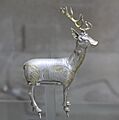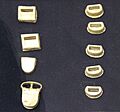Second Turkic Khaganate facts for kids
Quick facts for kids
Second Turkic Khaganate
𐱅𐰇𐰼𐰰:𐰃𐰠
Türük el |
|||||||||||||||||||
|---|---|---|---|---|---|---|---|---|---|---|---|---|---|---|---|---|---|---|---|
| 682–744 | |||||||||||||||||||
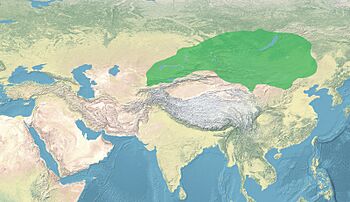
Approximate map of Second Turkic Khaganate, 720 AD.
|
|||||||||||||||||||
| Status | Khaganate (Nomadic empire) | ||||||||||||||||||
| Capital | Otuken (summer camp) Yarγan yurtï (winter camp) |
||||||||||||||||||
| Common languages | Old Turkic (official) | ||||||||||||||||||
| Religion | Tengrism (official) | ||||||||||||||||||
| Government | Hereditary monarchy | ||||||||||||||||||
| Khagan | |||||||||||||||||||
|
• 682 – 691
|
Elteriš Qaghan | ||||||||||||||||||
|
• 691 – 716
|
Qapγan Qaghan | ||||||||||||||||||
|
• 716
|
İnäl Qaghan | ||||||||||||||||||
| Tarkhan | |||||||||||||||||||
|
• 682 – 716
|
Tonyukuk | ||||||||||||||||||
|
• 716 – 731
|
Kul Tigin | ||||||||||||||||||
| Legislature | Kurultay | ||||||||||||||||||
| History | |||||||||||||||||||
|
• Established
|
682 | ||||||||||||||||||
|
• Disestablished
|
744 | ||||||||||||||||||
|
|||||||||||||||||||
The Second Turkic Khaganate (Old Turkic: 𐱅𐰇𐰼𐰰:𐰃𐰠, romanized: Türük el, lit. 'State of the Turks') was a powerful empire in Central and Eastern Asia. It was founded by the Ashina clan of the Göktürks and lasted from 682 to 744. This empire was built after the earlier Eastern Turkic Khaganate fell. Its main center was a place called Ötüken near the Orkhon River. Later, a group they once ruled, the Toquz Oghuz, took over and formed the Uyghur Khaganate.
Contents
How the Turkic Khaganate Began
A few decades after the first Eastern Turkic Khaganate ended in 630, the Turkic people wanted to be free from the Tang dynasty of China. In 679, a leader named Ashina Nishufu was made their qaghan (ruler). He rebelled against the Tang, but was defeated and killed by his own men.
Another leader, Ashina Funian, then became qaghan. He also rebelled against the Tang. At first, they had some wins, but then they were defeated again. A wise leader named Tonyukuk believed that rebelling was the right thing to do. He felt it was the people's fault for giving up and killing Nishufu.
In 681, a distant relative of a former ruler, named Qutlugh, started another rebellion. He moved his people into the Gobi desert in 682. There, Qutlugh, his brother Bögü-chor, and Tonyukuk gained the support of most Turkic tribes. They fought successfully against the Chinese forces between 682 and 687.
In 687, Qutlugh, now known as Ilterish Qaghan, led his strong army to conquer the Turkic lands in what is now central and northern Mongolia. Between 687 and 691, they defeated and took control of the Toquz Oghuz and Uyghurs. The center of the Second Turkic Khaganate then moved to the Otuken mountains, near the Orkhon, Selenga, and Tola rivers.
Growing Stronger: The Khaganate's Rise
In 691, Ilterish Qaghan died, and his younger brother, Qapaghan Qaghan, became the new ruler. Between 696 and 697, Qapaghan took control of the Khitans. He also made an agreement with the Kumo Xi tribe. This helped stop the Tang armies from moving into the northeast and protected the empire's eastern border.
From 698 to 701, Qapaghan's empire grew even larger. Its northern and western borders reached the Tannu-Ola Mountains, Altai, and Tarbagatai mountains. After defeating the Bayirku tribe in 706–707, the Türks controlled lands from the Kerulen to Lake Baikal.
In 709–710, the Turkic forces defeated the Az and Chik tribes. They crossed the Sayan mountains and won a big victory against the Yenisei Kyrgyz. The Kyrgyz ruler was killed, and his family became loyal to the Göktürks for many years. In 711, Tonyukuk led Turkic forces across the Altai Mountains. They fought and won against the Türgesh army in Dzungaria. Tonyukuk even chased the Türgesh across the Syr Darya river, reaching the border of Tokharistan. However, in battles with Arab forces near Samarkand, the Turkic army faced difficulties and lost many soldiers. They struggled to return to the Altai in 713–714.
Challenges and Changes: A Time of Crisis
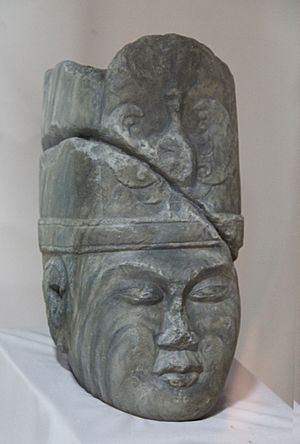
In 716, Qapaghan's son, Inel Qaghan, took the throne, which was against their usual rules. Because he had no right to rule, Inel and his supporters were killed by Kul Tigin. Kul Tigin had the support of many Turkic families. He then placed his older brother, Bilge Qaghan, on the throne. Bilge Qaghan ruled from 716 to 734.
Bilge Qaghan became ruler when the empire was almost falling apart. The western lands had broken away, and after Qapagan's death, the Türgesh leader Suluk declared himself ruler. The Kitan and Tatabi tribes stopped paying tribute, and the Toquz Oghuz rebellion continued. Even the Turkic tribes themselves started to rebel.
Feeling overwhelmed, Bilge Qaghan offered the throne to his brother, Kul Tigin. But Kul Tigin refused to go against the proper order of who should rule. So, Bilge decided to act. Kul Tigin was put in charge of the army, and Tonyukuk, who was highly respected by the tribes, became Bilge's closest advisor.
In 720, the Chinese Emperor Xuanzong of Tang attacked. But Tonyukuk defeated his cavalry, and the Turks pushed into Gansu. The next year, Emperor Xuanzong paid them a large amount of silk to stop fighting. In 727, Bilge Qaghan received 100,000 pieces of silk in exchange for a "tribute" of 30 horses. He refused to join the Tibet Empire against the Tang dynasty. His wisdom was praised by a Chinese official named Zhang Yue (Tang dynasty).
The Khaganate Starts to Weaken
The deaths of Tonyukuk in 726 and Kul Tigin in 731 meant Bilge Qaghan lost his best advisors. It is said that Bilge was poisoned, but the poison worked slowly. He managed to kill his attackers before he died. After Bilge, his elder son Yollig Khagan became ruler, and then Yollig's brother Tengri Qaghan took over.
After Tengri Qaghan died, the empire began to break apart. The ruling Ashina tribe found it harder and harder to control everything. The young Tengri Qaghan was killed by his uncle, Kutlug Yabghu, who then took power. A war started with the Uyghurs, Basmils, and Karluks tribes. Kutluk Yabgu Khagan and his followers were killed in these fights.
The Final Fall of the Khaganate
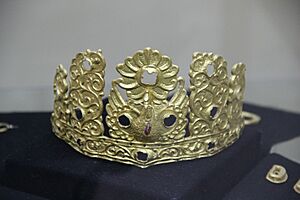
Kutlug I Bilge Kagan of the Uyghurs joined forces with the Karluks and Basmyls. Together, they defeated the Göktürks. In 744, Kutlug captured Ötüken and cut off the head of the last Göktürk ruler, Ozmish Qaghan. His head was sent to the Tang court in China.
Within a few years, the Uyghurs became the main power in Inner Asia and created the Uyghur Khaganate. Ozmish's son, Kulun Beg, tried to take over. The Tang emperor Xuanzong wanted to completely destroy the last parts of the Turkic Khaganate. He sent his general, Wang Zhongsi, to fight Kulun's forces. Meanwhile, Ashina Shi was removed from power by Kutlug Bilge Qaghan.
Wang Zhongsi defeated the eastern part of the Turkic army. Even though Kulun Beg tried to escape, the Uyghurs captured him. He was beheaded in 745, just like his father. Most of the Turks fled to other Turkic tribes like the Basmyl. However, a group including Qutluğ Säbäg Qatun, who was Bilge Khagan's widow and Tonyukuk's daughter, found safety with the Tang dynasty. The Tang emperor recognized her as a princess and made her the ruler of her people.
Who Ruled the Turkic Khaganate?
Khagans
| Khagan | Reign | Father, Grandfather |
Official Name
(Chinese reading) |
Personal Name
(Chinese reading) |
|---|---|---|---|---|
| Ilterish Qaghan | 682–692 | Etmish Beg, unknown |
Xiédiēlìshī Kèhán | 阿史那骨篤祿 Āshǐnà Gǔdǔlù |
| Qapaghan Qaghan | 692–716 | Etmish Beg, unknown |
Qiānshàn Kèhán | 阿史那默啜 Āshǐnà Mòchuài |
| Inel Qaghan | 716–717 | Qapaghan Qaghan, Etmish Beg |
Tàxī Kèhán | 阿史那匐俱 Āshǐnà Fújù |
| Bilge Qaghan | 717–734 | Ilterish Qaghan, Etmish Beg |
Píjiā Kèhán | 阿史那默棘連 Āshǐnà Mòjílián |
| Yollıg Khagan | 734–739 | Bilge Qaghan, Ilterish Qaghan |
Yīrán Kèhán | 阿史那伊然 Āshǐnà Yīrán |
| Tengri Qaghan | 739–741 | Bilge Qaghan, Ilterish Qaghan |
Dēnglì Kèhán | 阿史那骨咄 Āshǐnà Gǔduō |
| Ozmish Qaghan | 742–744 | Pan Kul Tigin, Ashina Duoxifu |
Wūsūmǐshī Kèhán | 阿史那乌苏米施 Āshǐnà Wūsūmǐshī |
Rulers During the Empire's End (741-745)
| Khagans | Reign | Father, Grandfather |
Official Name
(Chinese reading) |
Personal Name
(Chinese reading) |
|---|---|---|---|---|
| Kutluk Yabgu Khagan (took power illegally) |
741–742 | Unknown (not Ashina) |
N/A | Gǔduō Yèhù |
| Ashina Shi (claimed power, Basmyl chief) |
742–744 | Uti beg, Ashina Duoxifu |
Hèlà Píjiā Kèhán | Yīdiēyīshī |
| Kulun Beg (claimed power) |
744–745 | Özmiş Khagan, Pan Kul Tigin |
Báiméi Kèhán | Ashina Gulongfu |
How the Khaganate Was Organized
Under Ilterish, the Turkic state was put back together. It was a group of tribes that were related and worked together in a system. They shared common beliefs and family histories. They were also united by a single military and government system, and by general laws. The way the tribes were organized and the government structure worked together. This made their social connections strong and lasting.
The main group in the empire was made up of twelve Turkic tribes. The Ashina family, who were the rulers, led these tribes. The Toquz Oghuz were also very important politically.
Daily Life and Economy
The Turkic tribes mainly raised animals, moving from place to place. This is called nomadic cattle-raising. Hunting in the steppes and mountains was also important. It provided food and helped train warriors. A Chinese writer described their life: "They live in felt tents and wander following the water and the grass."
Horses were extremely important to the Türks. Horses could find food all year round, even under light snow. Sheep and goats would follow the horses, eating the grass the horses uncovered. Bulls, yaks, and camels were also valuable animals for them.
Beliefs and Religion
Tengrism was the official religion of the Second Turkic Khaganate. The rulers from the Ashina tribe believed that their right to rule came from Tengri, their sky god. Chinese sources say that Bilge Qaghan wanted to change to Buddhism and build cities and temples.
However, Tonyukuk advised him not to. Tonyukuk explained that their nomadic way of life made them strong warriors, much stronger than the Tang dynasty. He believed that if they became Buddhists, they would become peaceful and lose their military power. So, sticking to Tengriism was important for them to survive.
Relations with Other Powers
Tang Dynasty
The Turkic leaders had a complicated relationship with the Chinese Tang dynasty. Here's what one of their old stone writings, the Orkhon inscription, says about it:
While I have ruled here, I have become reconciled with the Chinese people. The Chinese people, who give in abundance gold, silver, millet, and silk, have always used ingratiating words and have at their disposal enervating riches. While ensnaring them with their ingratiating talk and enervating riches, they have drawn the far-dwelling peoples nearer to themselves. But after settling down near them these we have come to see their cunning.
Sogdia
During a raid led by Qapaghan Qaghan, the Türks took camels, women, girls, silver, and gold from a region called Sogdia.
Another old writing, the Bain Tsokto inscription, mentions this:
The whole Sogdian people leading by Asuk came and obeyed. Those days the Turkish people reached the Iron Gates.
Old Turkic: 𐰦𐰀:𐰘𐰼𐰝𐰃:𐰽𐰀:𐰉 Kassel:𐰍𐰺𐰆:𐰺𐰑𐰴:𐰉𐰆𐰑𐰣:𐰸𐰆𐰯:𐰚𐰠𐱅𐰃:𐰆𐰞:𐰚𐰇𐰤𐱅𐰀:𐱅𐰏𐱅𐰃:𐱅𐰇𐰼𐰝:𐰉𐰆𐰑𐰣:𐱅𐰢𐰼:𐰴𐰯𐰍𐰴𐰀:𐱅𐰃𐰤𐰾𐰃:𐰆𐰍𐰞𐰃, romanized: Anta berüki As-oq baslïγaru Soγdaq budun qop kelti jükünti ..tegti Türük budun Temir Qapïγqa Tensi oγulï.
Art and Important Objects

Many beautiful gold and silver objects have been found in the graves of the rulers of the Second Turkic Khaganate.
-
Silver Deer of Bilge Khan from the burial site at Khoshoo Tsaidam.
-
Silver tableware from Kul Tigin's burial site at Khoshoo Tsaidam.
-
Silver vessels from Kul Tigin's burial site at Khoshoo Tsaidam.
-
Gold belt ornaments, found at the Tonyukuk ritual place, Tov, Erdene.





